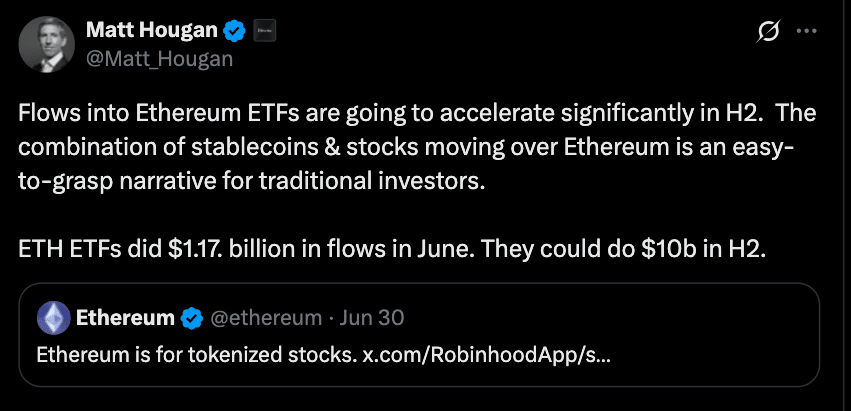According to Bitwise Chief Investment Officer Matt Hougan, inflows into Ethereum exchange-traded funds (ETFs) could hit $10 billion by the end of 2025. This follows a strong first-half and growing momentum from real-world tokenization use cases and regulatory clarity on staking.
Speaking recently, Hougan told investors that Ethereum’s role in powering tokenized assets like stocks and stablecoins is essential to attracting traditional investor interest. His forecast comes as Ethereum ETFs inflows have already reached over $1.5 billion so far this year, with $1.17 billion in June alone.
“Flows into Ethereum ETFs are going to accelerate significantly in H2,” said Hougan. “The combination of stablecoins and stocks moving over Ethereum is an easy-to-grasp narrative for traditional investors.”
Ethereum ETFs Have Strong First-Half
SoSoValue, an ETF tracking platform, confirmed that Ethereum ETFs saw net inflows in five of the first six months of 2025, showing sustained institutional interest. Although March saw a temporary outflow of $403 million, the market bounced back in Q2, driven by tokenization optimism and improving regulatory signals.

The $1.17 billion in June was the largest single-month inflow for Ethereum ETFs to date. Compared to Bitcoin’s $49 billion in ETF assets, Ethereum is still early in the ETF game. However, with assets under management approaching $4.2 billion, ETH is also being seen as a settlement layer for tokenized finance.
Staking Clarity Paves Way for Next-Gen Ethereum ETFs
Another big catalyst is the SEC’s recent ruling that crypto staking is not a securities offering. This subtle but important change opens the door for staking-enabled Ethereum ETFs, which would provide passive income through staking yields while tracking ETH’s price.
Several issuers, including Ark Invest, Fidelity, and VanEck, are already working on staking-based ETFs pending regulatory approval. Analysts think these products will accelerate Ethereum ETF inflows, especially among institutions looking for yield.
“We’ve been waiting for the greenlight on staking,” said a source familiar with ongoing ETF filings. “With the SEC’s latest position, we now expect a flood of second-generation Ethereum ETFs before Q4.”
Ethereum Network Upgrades Solidify Long-Term Value
Ethereum’s evolving infrastructure is also building investor confidence. The Pectra upgrade, deployed in Q2 2025, brought more efficient validator structures and better data compression; two technical achievements that improve scalability.
Later this year, Ethereum’s next upgrade; Glamsterdam, is set to improve throughput and gas efficiency. Combined, these will make Ethereum a robust, high-capacity settlement layer as tokenized asset volumes grow.
Developers and enterprise partners see these upgrades as crucial to Ethereum’s future, especially with ETF-backed adoption. As staking becomes more mainstream in regulated finance, a reliable, scalable network is non-negotiable.
Compared to Bitcoin ETFs: A Gap with Room to Close
Ethereum’s $4.2 billion in ETF assets is tiny compared to Bitcoin’s $49 billion, but the growth rate is steep. Inflows into ETH funds in Q2 were higher than expected and analysts think Ethereum could close the gap if staking ETFs and tokenization take off.

For context, Bitcoin spot ETFs, dominated early inflows with over $4.6 billion in June. Nevertheless, Ethereum’s position as a programmable base layer, offers a different kind of value proposition that could attract new institutional capital.
Conclusion
With Ethereum ETFs inflows already bringing in $1.5 billion in the first half of the year and new staking-enabled products on the horizon, Bitwise’s $10 billion projection for H₂ 2025 no longer feels far-fetched.
If the infrastructure holds and staking ETFs launch as expected, Ethereum could be in regulated markets by year-end. For now, all eyes are on Q3 to see if this next leg happens.
Overview
Ethereum ETFs have brought in $1.5 billion in 2025 so far, including $1.17 billion in June, and Bitwise’s CIO Matt Hougan thinks that will reach $10 billion by year-end. The forecast is based on Ethereum’s growing presence in tokenized assets like stocks and stablecoins and being relatable to institutional investors. Regulatory clarity on staking and upcoming ETFs will accelerate the flows. Ethereum’s infrastructure upgrades, Pectra and Glamsterdam, will also increase the network’s capacity and investor confidence. While Ethereum has less AUM than Bitcoin ETFs, strong H₂ will change that in the institutional crypto space.
FAQs
How much has Ethereum ETFs inflows in 2025?
$1.5 billion, $1.17 billion in June alone.
Why $10 billion in Ethereum ETF inflows for Matt Hougan?
He thinks Ethereum’s use in tokenized stocks and stablecoins makes it easy for traditional investors to get in.
How does staking impact ETF demand?
Staking provides passive yield and recent SEC guidance clears the way for staking ETFs.
How do Ethereum ETFs compare to Bitcoin ETFs?
Bitcoin has $49 billion in AUM, Ethereum ETFs have $4.2 billion.
Glossary
Ethereum ETFs inflows – Money into ETFs that track Ethereum’s price.
Tokenized stocks – Traditional equities on blockchain.
Staking ETF – ETF that earns yield by staking its crypto.
Pectra/Glamsterdam – Ethereum network upgrades for scalability and efficiency.
AUM (Assets Under Management) – Total value of an investment product.



















































































































